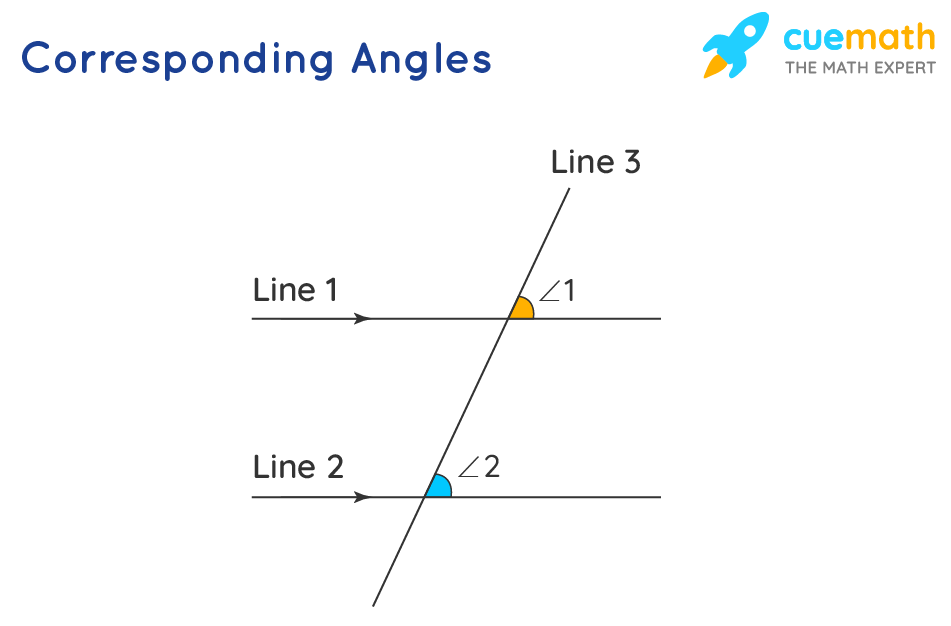Corresponding Angles
Corresponding angles are one of the types of angles that are formed when two parallel lines are intersected by the transversal. These are formed in the matching corners or corresponding corners with the transversal.
Corresponding angles have important applications in the areas of mathematics and physics. Understanding the corresponding angles is also useful in solving geometry-related problems, such as finding unknown angles or determining congruence between figures, etc.
| 1. | What are Corresponding Angles? |
| 2. | How to Find Corresponding Angles? |
| 3. | Corresponding Angles Theorem |
| 4. | FAQs on Corresponding Angles |
What are Corresponding Angles?
The corresponding angles definition tells us that when two parallel lines are intersected by a third one (transversal), the angles that occupy the same relative position at each intersection are known to be corresponding angles to each other.

According to geometry, and the definition of the corresponding angles, we can say that:
- Lines 1 and 2 are parallel. Thus, we have two parallel lines
- Line 3 intersects lines 1 and 2. Thus, we have a transversal.
- From the diagram, we can see that angles 1 and 2 are occupying the same relative position - the upper right side angles in the intersection region.
Hence, our corresponding angles definition seems to be justified. Therefore, we can say that angles ∠1 and ∠2 are corresponding angles.
Corresponding Angles Definition
We define corresponding angles mathematically as follows: "A pair of angles formed by two parallel lines and a transversal are said to be the corresponding angles if and only if
- one of them is interior and the other is exterior
- they are on the same side of the transversal and
- they are not at the same vertex"
By this definition, angles ∠1 and ∠2 in the above figure form a pair of corresponding angles. Corresponding angles are NOT always congruent.
- Corresponding angles formed by the transversal that intersects two "parallel lines" are angles that are congruent.
- When the transversal intersects two "non-parallel lines", the corresponding angles are NOT congruent.
How to Find Corresponding Angles?
We know that each intersection point has 4 angles. Now, each of the four angles in the first intersection region will have another one with the same relative position in the second intersection region.

Now, we will separate each of these four angles into different categories. Look at the table below to get a better understanding of the different types of corresponding angles.
| Pair of Corresponding Angles | Location |
|---|---|
| Angles 1 and 5 | Upper Right Side Angle |
| Angles 2 and 6 | Upper Left Side Angle |
| Angles 3 and 7 | Lower Right Side Angle |
| Angles 4 and 8 | Lower Left Side Angle |
Corresponding Angles Theorem
According to the corresponding angles theorem, the statement “If a line intersects two parallel lines, then the corresponding angles are congruent (equal)” is true either way. This theorem is also termed as "corresponding angles postulate".
The Converse of Corresponding Angles Theorem
The corresponding angles converse theorem would be, “If the corresponding angles are congruent, then the two lines are said to be parallel".
What if a transversal intersects two lines and the pair of corresponding angles are equal? Then, the two lines intersected by the transversal are said to be parallel. This is the converse of the corresponding angle theorem.

Important Notes on Corresponding Angles:
- When two parallel lines are intersected by a third one, the angles that occupy the same relative position at different intersections are called corresponding angles to each other.
- Corresponding angles are congruent with each other.
- If the corresponding angles in the two intersection regions are congruent, then the two lines are said to be parallel.
☛Also Check: Corresponding Angles Worksheets
Corresponding Angles Examples
-
Example 1: Have you ever noticed a tall building? In most tall buildings, each of its floors is designed in exactly the same way, especially the walls of the house on each floor. Compare the corresponding angles in such a case.
Solution:
Let us consider the bottom tiles of floor 1 as line 1 and that of floor 2 as line 2. Now, we know that line 3 is intersecting lines 1 and 2. In this figure, you can notice the geometry of the corresponding angles.

Can you see any similarity between angles 1 and 2? You can see that angles 1 and 2 are corresponding angles. Not only that, as all the floors are always built parallel to each other, we can say that lines 1 and 2 are parallel.
Answer: Therefore, ∠1 is corresponding to ∠2
-
Example 2: Did you ever notice the parallel lines on a railway track? There are multiple intersections of different smaller lines with the two main parallel track lines. Compare the angles made by the intersection.
Solution:
Can you see any similarity between the concept of congruent angles and angles 1 and 2 in the diagram given below? Recall the definition we used for corresponding angles to fit into our angles shown here.

You will be able to see that if we consider the track lines to be parallel, angles 1 and 2 can be considered as corresponding angles. Thus, if angle 1 is 90 degrees then angle 2 will also be equal to 90 degrees.
Answer: Therefore, ∠1 corresponds to ∠2 and angle 1 = angle 2 = 90 degrees.
-
Example 3: Have you ever come across two parallel streets? There is usually a connecting road between the two streets that also intersects it. Now, try to relate the angles made by the street at each intersection point with the two parallel roads.
Solution:
Apply our definition for corresponding angles to the angles shown here. You will see that according to our definition, these angles are corresponding!

Not only that, as all the streets are always built parallel to each other, we can also say that angles residing on the same relative positions on the streets will always be corresponding angles.
Answer: Therefore, Angles formed by parallel streets are corresponding angles.

FAQs on Corresponding Angles
What is the Meaning of Corresponding Angles in Geometry?
Corresponding angles in geometry are defined as the angles which are formed at corresponding corners when two parallel lines are intersected by a transversal. i.e., two angles are said to be corresponding angles if:
- the angles lie at different corners
- they lie on the same (corresponding) side of the transversal
- one angle is interior and the other is exterior angle
What are the Two Types of Corresponding Angles?
According to the definition of the corresponding angles, we can classify corresponding angles further into two types listed below:
- Corresponding angles - by transversal and parallel lines: Corresponding angles formed are congruent.
- Corresponding angles - by transversal non-parallel lines: Corresponding angles formed are not equal.
Do Corresponding Angles Add Up to 180?
The corresponding angles do NOT need to add up to 180 all the time. In some cases when both angles are 90 degrees each, the sum will be 180 degrees. These angles are known as supplementary corresponding angles.
What are Alternate and Corresponding Angles?
Alternate angles are angles that are at relatively opposite positions to each other; while the corresponding angles are the angles that are at relatively the same positions to each other.
Can Corresponding Angles be Consecutive Interior Angles?
No corresponding angles can not be considered consecutive interior angles because the consecutive interior angles are the angles that are on the same side of the transversal but inside the two parallel lines. But among every pair of corresponding angles, one is interior and the other is exterior.
Can Corresponding Angles be Right Angles?
If the transversal is perpendicular to the given parallel lines, then the corresponding angles of a transversal across parallel lines are right angles, and all angles are right angles as well at the intersection points.
What do you Understand by the Corresponding Angles Postulate?
According to the corresponding angles postulate, the corresponding angles are congruent if a transversal intersects two parallel lines.
Are Corresponding Angles Sum up to 90 Degrees?
If the corresponding angles are equal then in some cases when both angles are 45 degrees each, the sum will be 90 degrees. These angles are known as complementary corresponding angles.
What is the Converse of the Corresponding Angles Postulate?
The converse of corresponding angles postulates says, if the corresponding angles formed by two lines and a transversal are congruent, then the two lines are said to be parallel.
visual curriculum